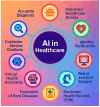AI-Driven Wearable Bioelectronics in Digital Healthcare
- PMID: 40710060
- PMCID: PMC12294109
- DOI: 10.3390/bios15070410
AI-Driven Wearable Bioelectronics in Digital Healthcare
Abstract
The integration of artificial intelligence (AI) with wearable bioelectronics is revolutionizing digital healthcare by enabling proactive, personalized, and data-driven medical solutions. These advanced devices, equipped with multimodal sensors and AI-powered analytics, facilitate real-time monitoring of physiological and biochemical parameters-such as cardiac activity, glucose levels, and biomarkers-allowing for early disease detection, chronic condition management, and precision therapeutics. By shifting healthcare from reactive to preventive paradigms, AI-driven wearables address critical challenges, including rising chronic disease burdens, aging populations, and healthcare accessibility gaps. However, their widespread adoption faces technical, ethical, and regulatory hurdles, such as data interoperability, privacy concerns, algorithmic bias, and the need for robust clinical validation. This review comprehensively examines the current state of AI-enhanced wearable bioelectronics, covering (1) foundational technologies in sensor design, AI algorithms, and energy-efficient hardware; (2) applications in continuous health monitoring, diagnostics, and personalized interventions; (3) key challenges in scalability, security, and regulatory compliance; and (4) future directions involving 5G, the IoT, and global standardization efforts. We highlight how these technologies could democratize healthcare through remote patient monitoring and resource optimization while emphasizing the imperative of interdisciplinary collaboration to ensure equitable, secure, and clinically impactful deployment. By synthesizing advancements and critical gaps, this review aims to guide researchers, clinicians, and policymakers toward responsible innovation in the next generation of digital healthcare.
Keywords: artificial intelligence (AI); digital healthcare; disease diagnosis; healthcare monitoring; wearable bioelectronics.
Conflict of interest statement
The authors declare no conflicts of interest.
Figures












Similar articles
-
Recent Advancements in Wearable Hydration-Monitoring Technologies: Scoping Review of Sensors, Trends, and Future Directions.JMIR Mhealth Uhealth. 2025 Jun 13;13:e60569. doi: 10.2196/60569. JMIR Mhealth Uhealth. 2025. PMID: 40513095 Free PMC article.
-
Revolutionizing e-health: the transformative role of AI-powered hybrid chatbots in healthcare solutions.Front Public Health. 2025 Feb 13;13:1530799. doi: 10.3389/fpubh.2025.1530799. eCollection 2025. Front Public Health. 2025. PMID: 40017541 Free PMC article.
-
Integrating artificial intelligence in healthcare: applications, challenges, and future directions.Future Sci OA. 2025 Dec;11(1):2527505. doi: 10.1080/20565623.2025.2527505. Epub 2025 Jul 4. Future Sci OA. 2025. PMID: 40616302 Free PMC article. Review.
-
Wearable technology for cardiovascular disease management: A global bibliometric analysis with emerging insights into artificial intelligence integration.Comput Biol Med. 2025 Sep;196(Pt B):110752. doi: 10.1016/j.compbiomed.2025.110752. Epub 2025 Jul 15. Comput Biol Med. 2025. PMID: 40669283 Review.
-
Revolutionizing surgery: AI and robotics for precision, risk reduction, and innovation.J Robot Surg. 2025 Jan 7;19(1):47. doi: 10.1007/s11701-024-02205-0. J Robot Surg. 2025. PMID: 39776281
References
-
- Zheng Y., Tang N., Omar R., Hu Z., Duong T., Wang J., Wu W., Haick H. Smart Materials Enabled with Artificial Intelligence for Healthcare Wearables. Adv. Funct. Mater. 2021;31:2105482. doi: 10.1002/adfm.202105482. - DOI
-
- Dai Y., Wang J., Gao S. Advanced Electronics and Artificial Intelligence: Must-Have Technologies Toward Human Body Digital Twins. Adv. Intell. Syst. 2022;4:2100263. doi: 10.1002/aisy.202100263. - DOI
-
- Zhang Y., Chen H., Song Y. Wearable healthcare monitoring and therapeutic bioelectronics. Wearable Electron. 2025;2:18–22. doi: 10.1016/j.wees.2024.12.004. - DOI
-
- Liao C., Xiong Y., Fu Y., Chen X., Occhipinti L.G. Organic semiconductors based wearable bioelectronics. Wearable Electron. 2025;2:23–39. doi: 10.1016/j.wees.2024.12.003. - DOI
Publication types
MeSH terms
Grants and funding
LinkOut - more resources
Full Text Sources

